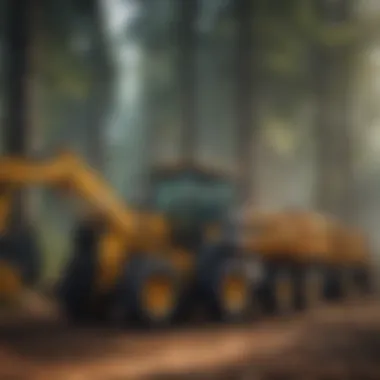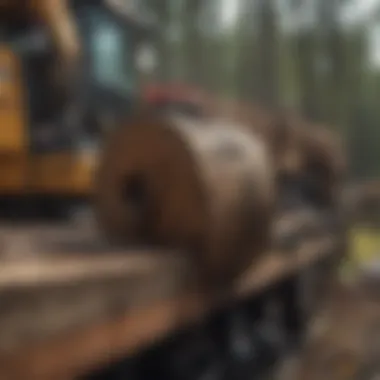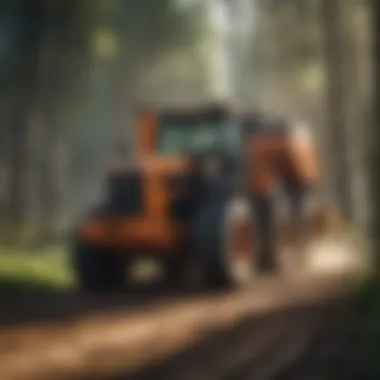Exploring the Machinery Trading Landscape in Forestry


Intro
The forestry equipment sector plays a crucial role in sustainable resource management. Machinery trading within this domain is vital for ensuring that operators have access to effective tools suited for various forestry activities. The exchange of machinery, from chainsaws to larger harvesting machines, is not just about buying and selling; it involves understanding the evolution of equipment, their specific applications, and the practices that drive successful trading.
Machinery traders must be equipped with knowledge about the types of equipment available, their capabilities, and the market dynamics that influence their prices and demand. In addition to knowing the hardware, there is a growing need to keep pace with technological advancements that are reshaping the landscape of forestry practices. This article aims to address these aspects comprehensively, offering valuable insights into the machinery trading sector for those involved in forestry management, trades, or simply interested in this niche market.
Prologue to Machinery Trading
Machinery trading in the forestry equipment sector is a critical aspect of modern forest management. This area involves the buying and selling of specialized machinery, which can significantly impact efficiency and productivity in forestry operations. Understanding this field is essential for professionals involved in forest management, agricultural trade, and even for those with a general interest in how this industry functions.
Definition and Importance
Machinery trading refers to the process of purchasing and selling equipment used in various tasks within the forestry sector. This includes everything from felling trees to processing wood and transporting it. The importance of this activity lies not just in the transactions but also in ensuring that the right equipment is used for specific tasks. This can enhance operational efficiency, reduce waste, and ultimately lead to better forest management practices. Moreover, it holds economic value; both buyers and sellers must navigate complex market conditions and make informed decisions to maximize their investment.
Scope of Forestry Equipment
The scope of forestry equipment encompasses a wide range of machines and tools designed for different tasks within forest management. This can be categorized into several layers:
- Cutting Equipment: This includes chainsaws and felling heads that are essential for converting standing timber into usable logs.
- Processing Machinery: Machines like harvesters and forwarders that handle the processing of timber once it has been felled.
- Log Handling Equipment: These are tools that aid in transporting logs from the cutting site to processing facilities or storage yards.
- Transport Equipment: Equipment like skidders, trailers, and trucks that are required to move heavy logs efficiently.
These categories represent a broad yet essential segment of the forestry industry, where the right machinery can greatly influence productivity. With advancements in technology, the availability and capability of these machines continue to evolve, further impacting how forestry operations are carried out.
Types of Forestry Equipment
Understanding the various types of forestry equipment is crucial for anyone involved in machinery trading. Each category of equipment plays a specific role in the forestry industry. Recognizing these differences helps traders make informed decisions and cater to the needs of their clients effectively.
Cutting and Felling Equipment
Cutting and felling equipment is essential for the initial stages of timber harvesting. This category predominantly includes chainsaws, feller bunchers, and harvesting heads. Chainsaws remain a staple in many forests due to their versatility and ease of use. Feller bunchers, on the other hand, are more efficient for larger operations. They can cut down multiple trees and gather them, enhancing productivity on site.
Evaluation of this kind of equipment often focuses on its power, weight, and ease of maneuverability. Buyers should consider the type of trees in their area and the volume they aim to harvest. Maintaining cutting and felling equipment properly is vital to extending its lifespan and ensuring efficiency.
Processing Machinery
After the cutting phase, processing machinery is critical for converting felled trees into usable logs. This includes equipment like debarkers, chipper machines, and mobile processors. Debarkers remove the bark from logs, enhancing their quality for further processing or sale.
In essence, the right processing machinery can drastically reduce waste, streamlining operations. Traders should assess the processing equipment based on its capacity and adaptability to different types of wood. Operators benefit significantly from machinery that integrates seamlessly with cutting equipment, creating a more efficient workflow.
Log Handling Equipment
Log handling equipment plays a critical role in transporting cut logs from the forest to processing sites. This includes equipment such as loaders, grapples, and forklifts specifically designed for logs. Loaders equipped with a grapple are particularly useful for moving heavy logs efficiently.
The choice of log handling equipment often depends on terrain and type of logs being handled. A proper balance between lifting capacity and maneuverability is important for traders to emphasize during negotiations. Ensuring operators are skilled at handling this equipment can increase safety and efficiency on site.
Skidders and Trailers
Skidders and trailers are fundamental for moving felled trees through the forest and onto transport vehicles. Skidders are designed to drag logs to a landing area, while trailers are used for transporting logs over longer distances. Selecting the right skidder is dependent on the form of terrain and the volume of logs being handled.
Investing in high-quality skidders and trailers can significantly impact operational productivity. They must be durable enough to endure rough conditions commonly found in forestry. Traders should focus on the load capacity and design to match various forest conditions.
Ultimately, each category of equipment plays a pivotal role in the lifecycle of forestry operations. As such, understanding these types is essential for traders looking to thrive in machinery trading.
Key Players in the Market


Understanding the machinery trading landscape in the forestry equipment sector necessitates an examination of the key players involved. These players, ranging from major manufacturers to regional distributors and online marketplaces, significantly influence how equipment is bought and sold. They also affect pricing, availability, and the overall dynamics of the market.
There are several notable benefits from recognizing these key players. First, it helps traders understand where to source equipment. Second, knowing the major manufacturers can assist in evaluating equipment quality. Finally, understanding regional distributors can provide insights into pricing models and local market demands.
This section discusses the major machinery manufacturers, regional distributors, and the role of online marketplaces in the forestry equipment sector.
Major Machinery Manufacturers
Major manufacturers play a fundamental role in the forestry machinery market. Companies like John Deere, Caterpillar, and Komatsu are notable for their extensive product ranges and established reputations. Each manufacturer brings a unique set of technologies and innovations to the market.
When considering purchasing, it is essential to evaluate each manufacturer’s equipment based on the specific needs of a project. For example, John Deere is renowned for its advanced forestry machines with robust operating capabilities. In contrast, Caterpillar often focuses on heavy-duty machinery suited for rough terrains.
Key Takeaways:
- Each major player offers specialized machinery, tailored for different forest management tasks.
- Understanding product lines can guide equipment selection and procurement strategies.
- Reliability and service support are crucial factors when deciding on a manufacturer.
Regional Distributors
Regional distributors serve as the bridge between manufacturers and end-users. They often understand local market needs and equipment requirements better than global manufacturers. Distributors may offer additional services like maintenance, repairs, and financing options, making them invaluable for buyers.
By engaging with regional distributors, forestry professionals can also gain insights into local trends and pricing strategies.
- Advantages of Regional Distributors:
- Knowledge of local and regional markets
- Personalized service and support
- Faster delivery times due to proximity
Online Marketplaces
In recent years, online marketplaces have gained traction as a viable option for buying and selling forestry machinery. Websites such as MachineryTrader.com and eBay provide platforms for consumers to find a wide array of equipment from various sellers. This has increased the accessibility of machinery to a broader audience.
However, potential buyers need to exercise caution when using these platforms. It is important to thoroughly vet sellers and check equipment conditions to ensure a satisfactory purchase.
"Online marketplaces revolutionize the way users access forestry machinery by offering diverse options and flexibility.”
Considerations for Online Marketplaces:
- Verify seller credentials to avoid fraud
- Look for equipment reviews or ratings
- Be aware of shipping costs and logistics
In summary, understanding the key players in machinery trading for forestry equipment equips professionals with the knowledge needed to make informed decisions. From evaluating major manufacturers and regional distributors to navigating online marketplaces, each aspect plays a critical role in the effectiveness of the trading process.
Challenges in Machinery Trading
The forestry equipment trading landscape presents several challenges that affect both sellers and buyers. Understanding these challenges is crucial for stakeholders to navigate the market effectively. Each of these obstacles can impact profitability, operational efficiency, and the sustainability of forestry practices.
Market Volatility
Market volatility is a prominent challenge in the machinery trading sector. Prices for forestry equipment can fluctuate significantly based on factors such as demand, supply constraints, and global economic conditions. For instance, if demand for lumber surges due to a housing boom, the price of cutting and felling equipment may increase.
- Traders need to be aware of these market dynamics to make informed decisions. Monitoring trends, whether they are seasonal or influenced by broader economic shifts, is essential.*
- The impact of fluctuations can be profound:
- Inventory management can become complex, as overestimating demand might lead to excess stock.
- Investment risks increase when buying equipment that may decrease in value quickly.
"Understanding market patterns and trends is not just advantageous; it is vital to ensure competitive positioning in the market."


Regulatory Compliance
Navigating regulatory compliance is another prominent challenge in machinery trading. Regulations in the forestry sector can vary significantly by region and may impact the types of machinery that can be sold or purchased. Standards may concern emissions, safety features, or operational limitations. Ensuring adherence to these regulations is not only a legal requirement but also a moral one, promoting sustainable practices.
- It is crucial for traders to:
- Failure to comply with regulations can result in hefty fines and a damaged reputation amongst buyers.
- Stay updated on local and international regulations.
- Consult with regulatory bodies when necessary.
Sustainability Concerns
Sustainability is increasingly becoming a concern in the forestry equipment market. With the growing emphasis on environmental responsibility, companies are pressured to adopt sustainable practices. The challenge lies in balancing profitability with a commitment to sustainable forestry.
- Traders must consider:
- As consumer preferences shift towards environmentally friendly options, traders may find opportunities in green technologies, but must also stay ahead of sustainability trends to remain competitive in the market.
- Product sourcing: How equipment is manufactured and what materials are used may impact buying decisions.
- Waste management: Navigating the disposal and recycling of old equipment poses logistical and ethical considerations.
Technological Advancements
Technological advancements play a pivotal role in the machinery trading landscape, particularly within the forestry equipment sector. As the industry evolves, innovations lead to improved productivity, enhanced safety measures, and optimized operational efficiency. Understanding these advancements enables traders to make informed decisions while navigating a competitive market.
Automation in Forestry Equipment
Automation in forestry equipment has transformed traditional practices. New machinery equipped with automated processes reduces human error and enhances precision in tasks such as cutting and felling. For instance, robotic arms and automated saws can execute complex operations that require high accuracy. This minimizes waste and improves the rate of timber recovery, which is increasingly valuable in today's market.
Moreover, automated equipment often results in cost savings for operators. By decreasing reliance on manual labor, businesses can shift resources towards other vital operational areas. However, adopting automation requires a careful evaluation of initial investment costs against long-term benefits. The trend continues to roll out advanced solutions, influencing trading behavior in the market.
Data Analytics for Traders
Data analytics has emerged as a critical tool for traders in the forestry machinery market. By leveraging data-driven insights, traders can better understand market dynamics and customer preferences. This allows for more precise targeting and customization of services.
Utilizing analytics aids in forecasting demand, giving traders a significant edge in inventory management. By analyzing sales patterns and market trends, traders can optimize their stock levels and avoid overstocking or stockouts. For instance, tools such as business intelligence software can provide real-time data, enabling quick adjustments to trading strategies.
Ultimately, those who embrace data analytics can increase their competitiveness, enhancing their understanding of both local and global market conditions.
Enhancements in Equipment Efficiency
Improvements in equipment efficiency are a result of ongoing technological innovations. Modern forestry equipment integrates state-of-the-art engines and systems that maximize fuel use and minimize emissions. This not only aligns with regulatory standards but also appeals to environmentally conscious buyers in the market.
Technological enhancements such as GPS technology and telematics systems have also enabled better monitoring of equipment performance. Traders can now provide their clients with insights on how equipment operates under different conditions, ensuring that buyers have the best possible tools for their operations.
Buying and Selling Practices
Buying and selling machinery in the forestry equipment sector involves nuanced practices that significantly affect the transaction's outcome. Understanding these practices is essential for both buyers and sellers. They influence price negotiation, equipment reliability, and overall customer satisfaction. The dynamics of the market can shift rapidly, making it vital for traders to stay informed about these practices.
Evaluating Equipment Condition
Assessing the condition of machinery before a purchase is critical. Buyers should conduct thorough inspections. This process includes reviewing the machine’s operational history, physical wear, and any previous repairs. The following aspects should be part of the evaluation:
- Physical inspection: Look for visible signs of wear or damage.
- Operational checks: Ensure that all equipment functions correctly.
- Documentation: Verify maintenance records and service history.
This careful evaluation can help buyers avoid costly repairs later. A sound understanding of the actual equipment condition can lead to more informed decision-making. Additionally, sellers who provide detailed information about their machinery foster trust.
Negotiation Techniques


Effective negotiation is crucial in machinery trading. Establishing a rapport with the opposite party is often the first step. This foundation can facilitate better terms. Some techniques include:
- Market research: Understanding the fair market value of the equipment can help establish negotiation baselines.
- Setting clear limits: Knowing your budget and sticking to it can prevent hasty agreements.
- Flexibility: Being willing to compromise can lead to a mutually beneficial outcome.
Negotiation is not just about price; it includes payment terms, warranties, and delivery conditions. The more comprehensively each party approaches the negotiation, the smoother the transaction will likely be.
Financing Options for Buyers
Selecting the right financing options can significantly affect the affordability of purchasing equipment. Many buyers may explore various financial avenues. Notable options include:
- Traditional loans: These allow buyers to spread costs over a longer period but may involve interest payments.
- Leasing programs: Leasing enables access to equipment without the need for a large upfront payment. This can also help manage cash flow.
- Vendor financing: Some equipment manufacturers offer direct financing options, which can sometimes provide more favorable terms.
Each financing option has its advantages and disadvantages. Buyers should evaluate their financial situation and future needs before making a decision. Understanding these elements not only simplifies the purchasing process but also supports long-term financial planning.
"Strategic decisions in buying and selling machinery can either enhance or hinder business operations in forestry."
By focusing on these buying and selling practices, participants in the forestry equipment market can navigate complexities with better outcomes.
Market Trends and Future Outlook
In the rapidly evolving landscape of machinery trading, staying ahead of market trends is crucial for anyone involved in the forestry equipment sector. Understanding these trends offers insight into the direction the industry is heading, enabling traders, manufacturers, and buyers to make informed decisions. This section explores the significance of growth projections, emerging markets, and sustainability within this niche.
Growth Projections
Forecasting the future of machinery trading requires a careful analysis of past and present market conditions. Analysts predict a steady growth in the forestry equipment sector, driven by factors such as increased logging activities, advancements in technology, and a growing emphasis on sustainable practices. The demand for efficient machinery will likely rise as more companies seek to improve productivity and reduce operational costs. Moreover, the integration of automation and data analytics into machinery operations is set to transform traditional practices, pushing the market forward.
Investing in machinery that aligns with these growth projections can yield significant returns. However, stakeholders must remain vigilant and adaptable to changes, as fluctuations in global trade policies and economic conditions can impact growth trajectories.
Emerging Markets
Emerging markets play a vital role in redefining the scope of machinery trading. Regions such as Southeast Asia and parts of Africa are witnessing an uptick in forestry activities due to their abundant natural resources. As local economies develop, so does the potential for investment in modern machinery. International traders are now focusing on these regions, seeing an opportunity to provide equipment suited for both small-scale and large-scale operations.
These markets may present unique challenges, including differing regulatory landscapes and varying levels of infrastructure development. However, the potential for growth makes them attractive. They offer a fresh avenue for established companies and new entrants alike to tap into an expanding customer base. Understanding local needs and building strong relationships with regional distributors will be paramount for success in these sectors.
Sustainability and Eco-Innovation
Sustainability continues to shape the future of machinery trading in forestry. As environmental concerns gain momentum, manufacturers and traders must prioritize eco-friendly equipment. This shift is not merely a trend; it has become a necessity as regulations around emissions and sustainability practices tighten. The push for sustainable forestry practices translates into a demand for machinery that minimizes ecological impact while maximizing productivity.
Eco-innovation is a crucial aspect of this trend. Companies are developing machinery designed to operate more efficiently, reducing fuel consumption and waste. For instance, equipment that includes hybrid or electric options is becoming increasingly prevalent, appealing to a growing segment of environmentally conscious buyers.
"The future of machinery trading lies in aligning business practices with sustainable development goals."
To navigate the changing landscape, traders must educate themselves about sustainable technologies and advocate for practices that balance productivity with environmental stewardship. This knowledge not only helps build a positive brand image but also meets the expectations of consumers who prefer sustainable options.
Closure
The conclusion of this article serves to emphasize the vital role that machinery trading plays within the forestry equipment sector. By synthesizing key insights and trends presented throughout, it encapsulates the essence of trading in this niche market. Understanding machinery trading is not merely about buying and selling equipment; it involves a comprehensive grasp of market dynamics, technological advancements, and the increasing importance of sustainable practices.
Final Thoughts on Machinery Trading
As discussed, machinery trading transcends basic transactions. It demands a nuanced understanding of various equipment types and their specific functions. Traders must navigate complex relationships with manufacturers and distributors while keeping an eye on market demands.
Moreover, the evolving landscape of technology in forestry equipment introduces new opportunities as well as challenges. Automation and data-driven strategies are beginning to redefine how trades are made, pushing traditional boundaries. Staying informed about these shifts is essential for anyone serious about success in the field.
"In forestry machinery trading, knowledge is just as crucial as the equipment itself."
Implications for the Forestry Industry
The implications of effective machinery trading extend far beyond individual transactions. As machinery traders embrace innovative practices and technologies, they inherently shape the future of the forestry industry. Efficient trade practices contribute to better resource management and environmental sustainability.
Furthermore, as markets expand and new trading platforms emerge, the ability to adapt becomes increasingly critical. For professionals in the field, understanding these trends makes a significant difference in not only achieving success but also contributing positively to the broader industry. In essence, the intricate web of machinery trading serves as the backbone for progress in forestry, influencing everything from operational efficiency to environmental stewardship.



